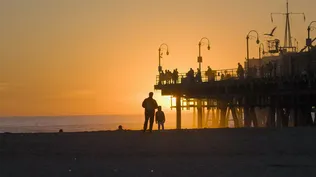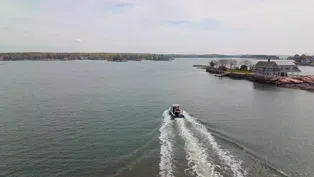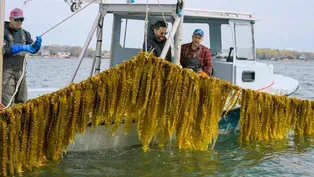
Groundbreaking Clean Energy Technologies
Clip: Episode 1 | 8m 29sVideo has Closed Captions
Ari visits exciting, large-scale solar and nuclear energy solutions operating today.
Ari explores an ancient cathedral in Spain and emphasizes the need for "cathedral thinking" — building beautiful things that will last far beyond our own lifetimes. Later, Ari travels to Morocco where a massive solar power plant is supplying renewable energy to a significant portion of the country.
Problems with Closed Captions? Closed Captioning Feedback
Problems with Closed Captions? Closed Captioning Feedback
Supported by the Hoveida Family Foundation and The Rosalind P. Walter Foundation.

Groundbreaking Clean Energy Technologies
Clip: Episode 1 | 8m 29sVideo has Closed Captions
Ari explores an ancient cathedral in Spain and emphasizes the need for "cathedral thinking" — building beautiful things that will last far beyond our own lifetimes. Later, Ari travels to Morocco where a massive solar power plant is supplying renewable energy to a significant portion of the country.
Problems with Closed Captions? Closed Captioning Feedback
How to Watch A Brief History of the Future
A Brief History of the Future is available to stream on pbs.org and the free PBS App, available on iPhone, Apple TV, Android TV, Android smartphones, Amazon Fire TV, Amazon Fire Tablet, Roku, Samsung Smart TV, and Vizio.
Buy Now

What It Means to Be Human
A Brief History of the Future explores the human ability to increase empathy and compassion, what values we are instilling into artificial intelligence technologies, and the need to create both a better world and a better humanity for life to flourish on this planet.Providing Support for PBS.org
Learn Moreabout PBS online sponsorship[soft music] ♪ ♪ - There's a phrase called "cathedral thinking."
And what that means is, how do we go about making decisions in the same ways that those who built ancient cathedrals thought?
Because when they were building cathedrals, I mean, more often than not, the architect and the initial builders of a cathedral wouldn't even be around to see it actually completed.
It wouldn't happen in their lifetime.
So they had to make these decisions in a way where they were literally laying the cornerstone for something that they would never actually see completed, but they were doing it for the next generation.
I came to Cordoba to see firsthand a project that has been many, many generations in the making.
[both speaking Spanish] - It's awe-inspiring to experience something that those who started never lived to see completed built as a gift to those yet to be born, a reminder that the future is being built on our actions right now.
The future is a verb.
It's something we do.
We can become great ancestors.
And that is what the future needs us to do right now, to think in a way that places us in their shoes.
- This idea of stepping back to see ourselves and the work we do in this moment as a piece of something larger is so powerful, and it has the potential to unlock bigger, better ideas worth working towards in the years to come.
It's my first time in Morocco, and I've read about this massive solar power plant for a while now.
And to be able to come and visit it is kind of like a dream come true.
It's a little bit, you know, solar alternative renewable energy geek in me.
But to see a plant kind of come up in the middle of the desert using the latest technology that can power a huge part of the country is amazing for me.
So tell me, where are we right now?
- So in this area right here just alone, how many of these mirrors are there?
- 2 million?
- 2 million.
- 2 million of these panels?
- Yeah.
- OK. - And all one.
- The complex here is the largest concentrated solar power plant in the world, generating enough power to supply a million homes in Morocco with renewable electricity.
And in a country that doesn't have a natural supply of oil, natural gas, or coal, they believe this is the start of something even bigger.
What is kind of your hope and your dream for Morocco in terms of the raw resources that are coming to your land from the sky?
- What could an energy-independent future look like, not just here but everywhere?
What impact will it have on our politics, our health care, and the well-being of the natural world when we create a future independent from fossil fuels?
Solar technology is just one piece of making that future a reality.
But as large-scale facilities are popping up in countries all over the world, the goal of powering major cities and entire countries is getting closer every day.
In northern California, scientists are taking a similar approach by applying long-term thinking to the challenges facing us today, pursuing a long-held dream of limitless clean energy.
- I'm Annie Kritcher.
I was a lead designer for the ignition experiment.
We are at the National Ignition Facility in Livermore, California.
What we do here is, we take two atoms, and we smash them together, and we make a heavier atom.
And that process releases energy.
- And so you're literally for 90 trillionths of a second creating a mini sun.
- That's correct.
The reason that we need to generate stars on Earth is to reach the extreme conditions that are required to get two atoms to fuse together.
So you need tens of millions of degrees to do that.
We have 192 laser beams which enter the ends of a hollow cylinder.
And then they hit the hollow cylinder on the inside.
And that creates an oven, a very hot X-ray oven, which is 3 million degrees.
And inside of the cylinder sits a little tiny capsule the size of a BB.
And inside of that little tiny BB sits the deuterium and tritium that we want to fuse together.
And so this intense X-ray oven heats the outside of the capsule, explodes that material outward, and just like a rocket, where the rocket fuel goes out and that pushes a rocket up, we're squeezing the material down to half the size of a human hair from the size of a BB.
Because of that outward expansion, we get an implosion.
- What is the goal of this work in the big picture?
- Nuclear fusion could provide clean, limitless, abundant energy for mankind.
Fusion is really the Holy Grail of energy.
- That dream reached a major milestone here recently as Annie's team led an experiment that successfully created ignition for the first time.
- This is the target bay.
Here we have the target chamber, which is in blue.
It's a spherical chamber.
It's about 10 meters in diameter.
And here, the laser beams come into the chamber.
The laser beams are what drives our experiments.
- If it's a 10-chapter book, what chapter are we in right now in this room?
- I'd say we're not in chapter 1, because we've been working on this for quite a long while.
And we just had the breakthrough.
I guess, maybe chapter 3.
The person that came up with the concept to do this did so before I was born.
So it is really a passing-the-torch, multi-generation problem, big-science problem.
- How should we be thinking about challenges like this?
- I think it's really important to consider the long-term benefits and also the generations coming after us to create a clean world for them and to give them the necessary means to be able to generate energy in the future.
So it's a really important grand challenge.
And it's just so important for our future generations.
- One of the most exciting things about this moment is that we have the tools and potential to shape the future in ways that have never been possible before.
The choices we make around how we develop our technologies here and now will set a path for future generations to build on.
Employing Long-Term Thinking to Empower Better Solutions
Video has Closed Captions
Bren Smith shares his journey to promote sustainable practices in the fishing community. (10m)
Providing Support for PBS.org
Learn Moreabout PBS online sponsorshipSupport for PBS provided by:
Supported by the Hoveida Family Foundation and The Rosalind P. Walter Foundation.















